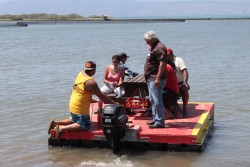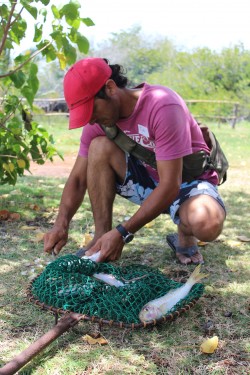Two Islands, One Goal

Hanohano Naehu (far left, in yellow) gives the Rapa Nui visitors a tour of the spring bordering the fishpond. Photo by Clare Mawae.
On a bright and breezy Thursday morning, two men from different parts of the world knelt over a pile of freshly netted weke. One was a Molokai born-and-raised fishpond keeper, the other, a Spanish-speaking Rapa Nui fisherman, each knowing just a few words of the other’s native tongue. Under a shady tree, they pulled out knife and fork and began scraping translucent scales from the fish in the same methodical style. Neither could say very much to each other, but they spoke the common language of men whose livelihoods revolve around fish.
It was this connection to the ocean, to kai, to el mar, that brought a conglomerate of Hawaiians and Rapa Nui together last month at Keawanui Fishpond on Molokai’s east end. The 11 Rapa Nui visitors, a mix of traditional fishermen, a shore gatherer and a conservation lawyer, had come to learn about Hawaiian methods of ocean preservation and fish growth.
“It’s really a dream come true to be able to see these experiences, and look for tools that will help us go back to the island and face the challenges that we have,” traditional Rapa Nui fisherman Arturo Olivares said through a translator.
The trip was organized by representatives from The Pew Charitable Trusts, whom Keawanui Fishpond keeper Hanohano Naehu had once met while lobbying in Washington, D.C. Pew has a project called Global Ocean Legacy, which does work on protected marine areas around the world. Seth Horstmeyer, the project’s director, and Emily Owen, a Pew senior associate, connected with Naehu to bring the Rapa Nui a special experience.
Easter Island, or Rapa Nui, is part of Chile but is located nearly 2,300 miles west of the South American country. The 63-square-mile island is perhaps best known for its towering stone statues, or moai, whose construction is still a mystery to historians and anthropologists.
Although the ocean isolates Rapa Nui from much of the world, its waters have become crowded with foreign fishing boats, as evidenced by the trail of buoys left behind marked in Spanish, Japanese, English and Chinese, explained the fishermen.
“We go back to the same places where our families have fished for generations,” said Olivares. “… We’ve noticed though that before, we would have enough fish to be able to have sustenance for our families and our local economy and such, but recently we’ve been having problems and we don’t have as much fish as we used to.”
Horstmeyer said the fishermen are seeking to identify areas for conservation along the coast as well as determine ways to make those protected areas sustainable. Understanding how Keawanui Fishpond operates, they hoped, would help them with these goals.
Sustainability, said Naehu, whose official title is kia`i loko or fishpond guardian, is “not just a hip and fad” word around fishponds: it’s how the whole property is engineered. Owned by Kamehameha Schools, Keawanui Fishpond currently encompasses 50 acres and 2,000 feet of rock wall. It’s the largest fully functioning fishpond on Molokai, meaning that it includes three main components: rock walls built higher than the highest tide, working makaha (gates) to keep fish in or out and freshwater springs to provide fish with vital early stage nutrients.
“The ancestors on Easter Island, they did something similar,” said Rapa Nui fisherman Tomás Tuki. “But there aren’t a lot of good refuges on Easter Island, so they’re on a much smaller scale than they are here.”
Melding Old and New

Fishpond keeper Hanohano Naehu (far left, in yellow), takes Rapa Nui kupuna out to explore the pond’s borders. Photo by Clare Mawae.
Naehu took some of the Rapa Nui visitors out on a boat, showing them the makaha that let in small fish and allow them to grow while keeping bigger predators at bay, and the wire trap that allows the keepers to monitor fish growth. Naehu explained that they’re currently “sitting on an investment of small fish.”
The makaha at Keawanui are particularly distinct. While exploring fishpond construction throughout the state, Naehu said, he noticed a type of elongated, raceway-like makaha on Hawaii Island that he’d yet to see elsewhere, that “made the current look like a river.” The keepers at Keawanui wanted to mimic that flow and current in their own pond but needed a reason to implement those changes. Then the 2011 Japan tsunami sent high surf to Hawaii, destroying the fishpond walls, and a disaster became an opportunity.
“When tsunami completely fell the wall, it was an opportunity to not only put what our kupuna did from before but to put our twist on it,” said Naehu, who said the keepers at Keawanui took one year and three months to rebuild the wall. “We call it our thesis project.”
Every fishpond operator is different, explained kia`i loko Ua Ritte, and no one is wrong. Some won’t use any type of plant, rock or tool not found in ancient Hawaii. However, Ritte said, even if they use modern methods, it’s important to carry forward their work with the same kind of ancient values.
Preserving the old and the new is something the Rapa Nui fishermen said they hope to take forward with them as they seek to protect their coastline.
“We have to rescue the ancestral technique but combine it also with modern technology for today,” said Mandy Roe, a Rapa Nui shore gatherer who collects cowries for necklaces and shellfish from rocks along the ocean.
Ritte also explained that if you want to focus on growing fish, you have to think differently from a typical fisherman. He said some of the methods they use at Keawanui wouldn’t make sense to local fishermen. For example, while tangled roots of mangrove make fishing more difficult, Ritte said it helps cultivate fish growth and keeps the sediment in check.
“Fishermen no make good fish farmers,” said Ritte. “… They looking at how for catch the fish. We looking at how for grow the fish.”
A Common Cause

Rapa Nui fisherman Exequiel Tuki scrapes the scales off a pile of weke from the pond. Photo by Colleen Uechi.
While Rapa Nui fishermen have many ideas to help the situation of depleting resources, Olivares admitted the issue isn’t a priority for the Chilean government.
Naehu echoed the sentiment that restoring Hawaiian ways of life seem to be less of a priority than funding things like new sports facilities and the state’s big rail project. He said he felt “our future should look more like our past than our present,” where everything was sustainable and everyone could get enough food with the right skill set.
“We used to take care of the land because this was the store. Now everybody’s ahupua`a is Costco, it’s Walmart, it’s Friendly Market,” he said. “There’s no more sacredness, no more importance, and that’s gotta change. Hopefully that’s the story we can share with our brothers and sisters from Rapa Nui.”
The group ended the morning with a meal of Molokai fare: hearty venison, fish, crab and oysters pulled fresh from the pond. The Rapa Nui fishermen presented the Keawanui crew with gifts, and Naehu exchanged an oli and a pule with them.
Rapa Nui’s fishermen continued their journey to Mo`omomi with traditional resource manager Mac Poepoe, to learn more about Hawaiian fishing practices and efforts to designate the island’s north shore as a Community Based Subsistence Fishing Area (CBSFA). They also made plans to visit Oahu and Kauai, where a designation similar to the Mo`omomi CBSFA was recently passed.
“We’re learning a lot from our Hawaiian brothers here,” said Olivares. “Since we’re all family there’s a healthy envy, basically, seeing this and dreaming about how similar things can be implemented on Easter Island and taking inspiration from it.”











Don't have a Molokai Dispatch ID?
Sign up is easy. Sign up now
You must login to post a comment.
Lost Password